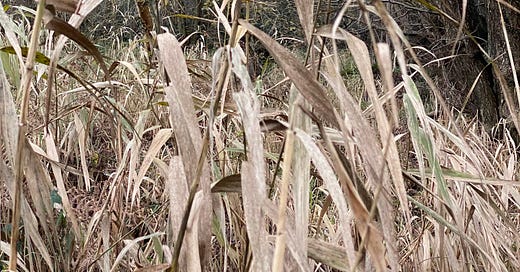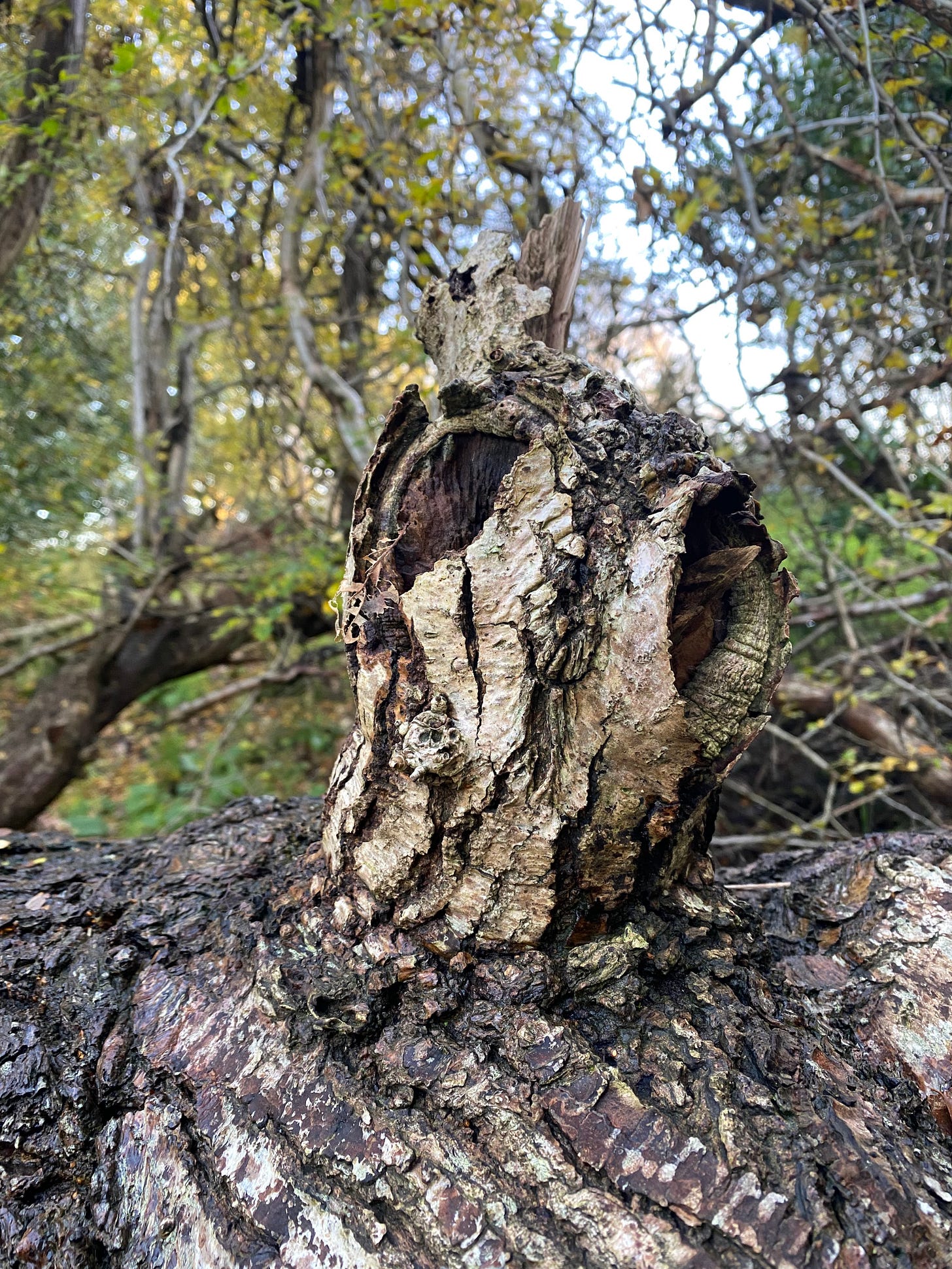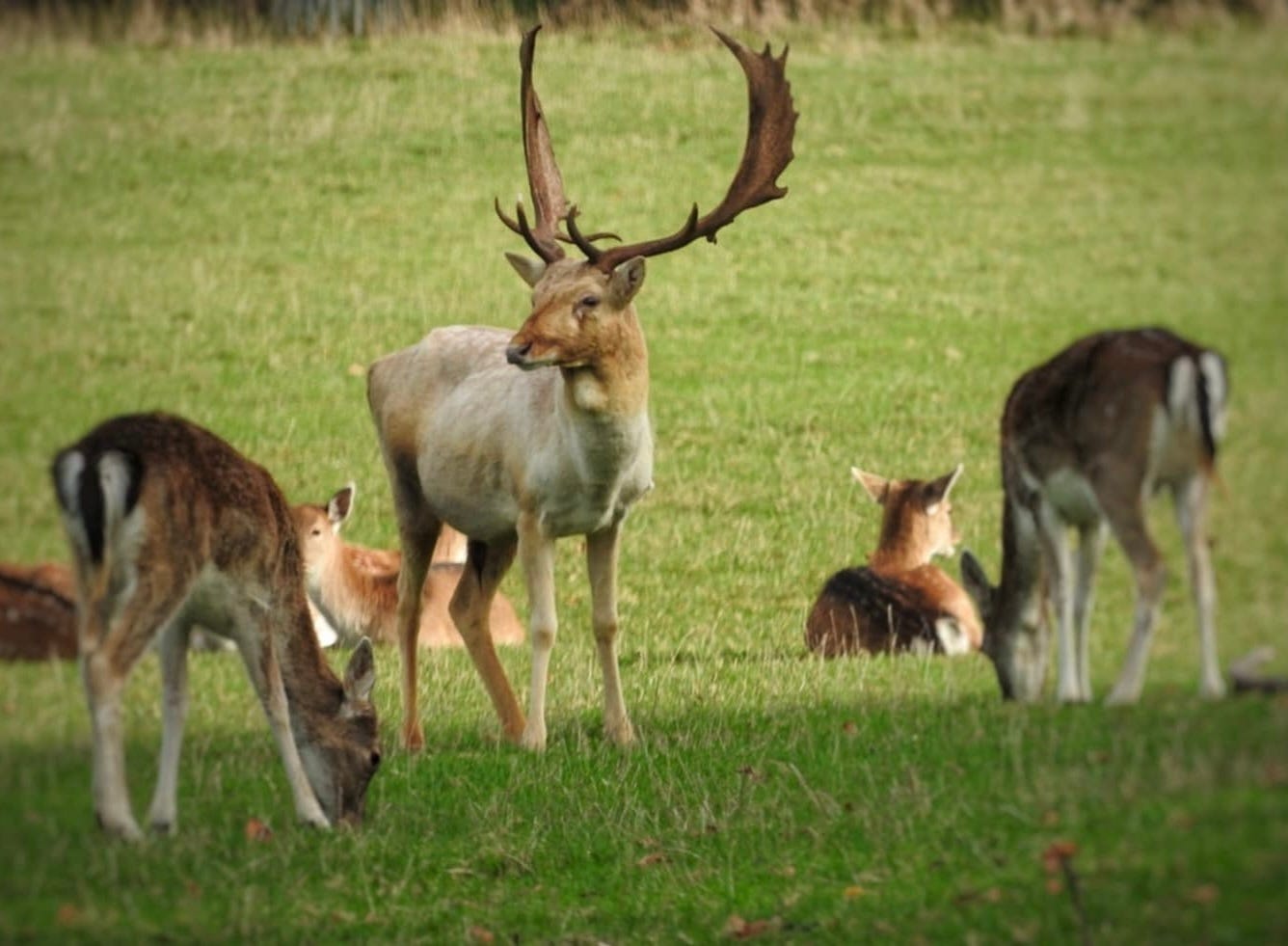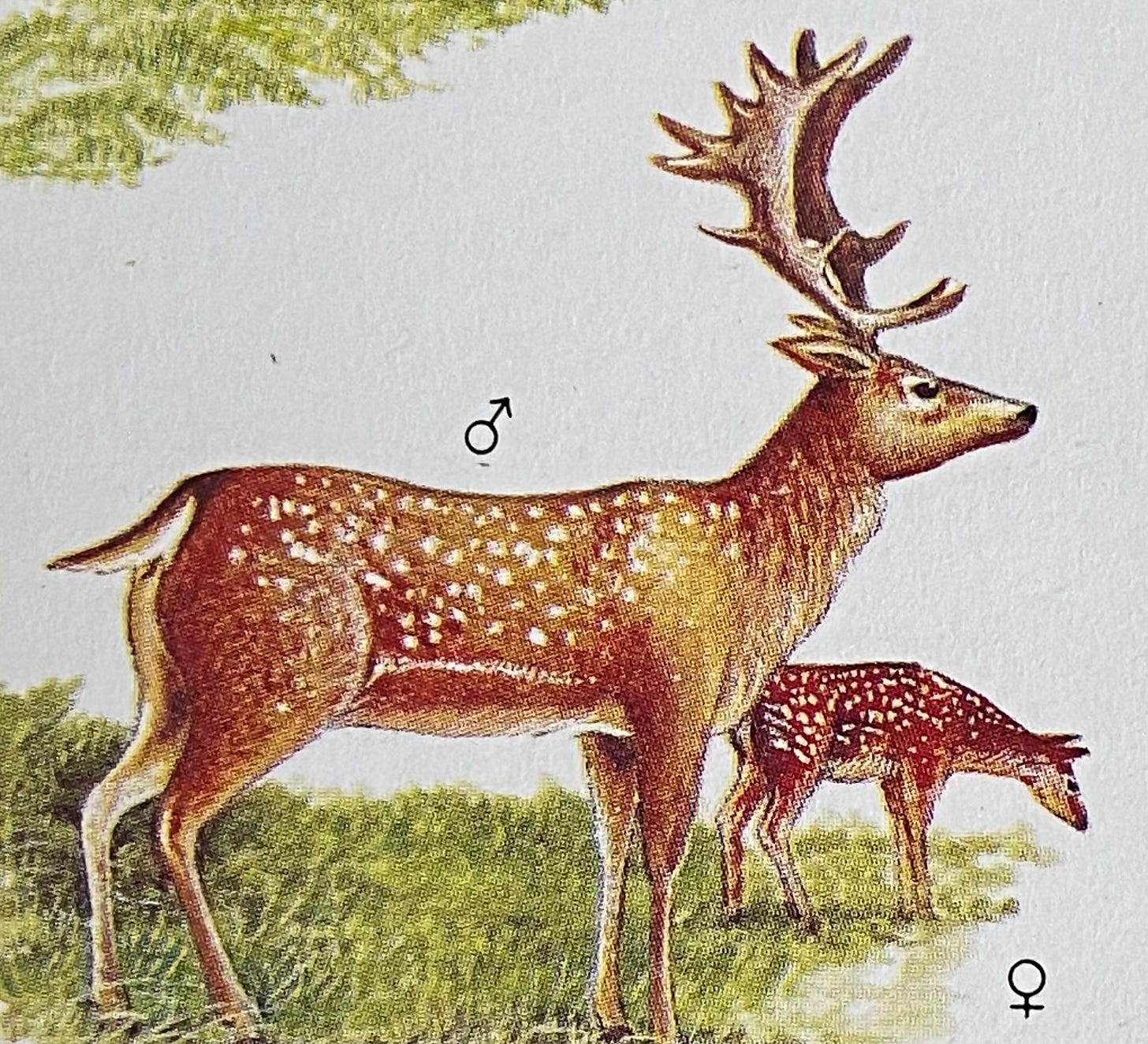Turning to winter: rustling reeds by the otter stream
Hello dear friends and welcome to this full moon/mid November edition of Bracken & Wrack. This is the one that falls closest to the two-year anniversary of our shared journey here.
If you’d like to see where it all began, you’ll find that very first newsletter, ‘November Days’, here. I remember how much I enjoyed stitching it into a sort of late-November patchwork quilt before emailing it to the 96 lovely candle customers who said they would be interested in a seasonal newsletter if I ever got around to producing one :-) Since then our wonderful community has grown to over 1000 and I am overjoyed to welcome you all at around the time of the new and full moons each month.
This was the manifesto I set out for Bracken & Wrack when I hit ‘publish’ for the first time on 23 November 2022:
‘My plan is to write about what’s happening in the countryside, around the cottage and garden, and little snippets of seasonal lore. A swirl of salt, earth, and circling dragonflies. With recipes, and, I hope, a dash of inspiration to carry with you to your own corner of the landscape. Certainly it will be a winding trail.
So, if you would like to step out beside me (as I very much hope you will) you will do well to top up your flask with a steaming brew and make sure your backpack has some tasty treats in the pockets to munch as we journey along the way together.
There will be news from The Old Shop each New and Full Moon, which no doubt will vary subtly as the energies shift. But time will tell. It’s free to subscribe, so please share this with any friends who may be interested. The more the merrier!’
I think - hope, anyway - that I have stayed true to these aims. Honestly it’s such a joy to know that you get to share in this little corner of north-east Norfolk and are, perhaps, inspired to look afresh at the folklore and landscape of your own homeland.
And here we are again, waiting for the first chink of re-kindled light as we sink further into the darkest part of the year. As I said then, it’s a time to light a candle, or candles; to reflect and to stay as cosy as we can. A time, too, to feel grateful for sparks of warmth, flame and wintry inspiration in the place we call home.
As you know, I live in the countryside and when I step out of the door towards the heath it’s a matter of moments before I encounter the flaming rose hips and golden fairy-flag birch leaves strung at ever increasing intervals along the boughs that I mentioned in that first edition of Bracken & Wrack. But I think that above all, I try in my writings to advocate living joyfully through the senses, in the moment, wherever you are and even through tough times. Noticing those tiny things with curiosity, and seeing where they lead. Making and keeping memories that can always be re-kindled through scent, touch, sound, taste and sight.
My lovely hand-reading friend Suzanne might say that she can see I need this physical connection with the land because my fingerprints show an unusual number of ‘earthy’ simple arches. But it’s my belief that every one of us lives more deeply and fully when we plug all our senses into those everyday rituals it’s so easy to perform without truly engaging to our very core.
Looking back over my old photos for this moment in past years, my eye was caught by an image-memory that happened very far from this rural corner of Norfolk but seems to perfectly exemplify this. Six years ago I spent a lovely but unimaginably chilly afternoon wandering the lanes of Brighton with my daughter - who went to Sussex Uni and loved it so much she stayed - amid Christmas lights and bustle and the scents of street food and beer. It really was so very cold that my nose and fingers were frozen and truth to tell, I was ready for a rest.
Suddenly we spotted an enormous tipi pitched between buildings on the wide pavement. Within its opened tent flap we could see the flicker of a hearth fire and tea light flames set in lanterns dotted everywhere, as the spicy aroma of mulled wine wafted towards us. The warmth was magnetic. Gratefully we entered the canvas portal to a scene that was even more inviting than it had appeared from the darkening street.
A wood fire had been kindled and woodsmoke curled to the central hole high above our heads. Its ashy logs glowed warmly, especially so if you could find a place on the rustic wooden benches that surrounded it. Rough wool and linen blankets and cushions made for cosy sitting and our feet sank into soft rugs. A sign at the entrance had told us that this was Thor’s Tipi, and we felt that we had truly entered the Hall of the Gods. A steaming cup of mulled wine between each of our hands soon relieved numb fingers and imparted both cheer and an inner glow while firelight kissed our faces. That first sip, all senses tingling, is a shared moment that stays with me still.
Poppy and me in Thor’s Tipi, Brighton, 17 November 2018. Valhalla found.
In this issue:
Thor’s Tipi
Poetry by Hilary Llewellyn-Williams
Music for the Edge of Winter
Inching Towards the Sea: a Morning Ritual
Grazing Between the Trees: the Fairy Cattle of Holkham Hall
Muffled Laughter: Introducing the Hikey Sprites
Forgotten Land: The Levellers & St Pega’s Well
Our fenlands, wastes,
moors, marshes and wild sloughs
are shrunken now, ploughed up -
but give them time. Decay
puts out its tendrils. Water
seeps upwards patiently.
Stands of reeds sing
high from behind clenched teeth,
knot their roots tight,
bow to the seasons, keep firm
and yielding. Lost souls
glint from the shallows.
All night the gale
scuds over us. Dawn
will be more naked still:
the trees will be peeled sticks.
I close my eyes and pull
the covers up, but lie
aware of blind movements:
small shift of the house
downwards, the closing in
of winter, thread of roots
through water - and here’s
that noise again, that shrill
dark reedy whistling.
Hilary Llewellyn-Williams, ‘Reed/Ngtal Oct. 28 - Nov. 24’ (extract), The Tree Calendar
MUSIC FOR THE EDGE OF WINTER
Crow Wood, 21 November 2021
On Martinmas this year - 11 November - I took a walk through Crow Wood, in search of the green that surprisingly seems to appear at this time of year, just when that colour is bleaching out from the landscape. The walk became part of my most recent YouTube video ‘Old All Hallows’ Eve at The Old Shop | Cosy Edge-of-Winter Days’. I’d stumbled upon the idea for this exploration, but found it provided another way of thinking about the old East Anglian folk tale The Green Children of Woolpit, which I had recounted in a video of two years ago, when I took another Martinmas walk through Crow Wood. This is the one I thought I would link here, as it not only gives a taste of the season but also an idea for making music from the bounty of nature.
I was walking through Acorn Wood, when I thought, why should we believe that the Fair Folk always have to look nearly like humans? Perhaps the Hidden Folk are so called because at the approach of human footsteps they quickly disguise themselves as trees and think we’ll never notice … 17 November 2023
INCHING TOWARDS THE SEA: a morning ritual
You always hold your breath along Old Lane at this time of year. Tractors and mud and the sheer size of the lorries that are liable to come hurtling towards you. Sugar beet bounced off the load onto the tarmac, rolling around until they’re split or crushed under those monstrous tyres. Then, their damp interior glows against the greyness of the day, strangely pale and vulnerable-looking. Sweet treasure for wild creatures; I have often noticed nibbled edges.
At least today it’s dry so the mud is waiting in the wings. Bump bump bump over the lumps. On the farm’s concrete hardstanding, a mound of lime, gleaming as whitely as the chalkland barrows must have done when strong arms, legs and hearts raised them high. I drive as fast as I dare, casting a prayer of gratitude when I meet the biggest farm vehicle imaginable at the perfect place for me to pull into a field entrance and move out again smoothly, all the time inching towards the sea.
And there it is. Plenty of room in the bays facing the waves so I have choice, and I pull Kizzy in right next to the slipway. Sand has drifted into the concrete corner here, but it feels sheltered, my own little place. A few spaces down, a white NV200 has its back doors open right onto the wall. I find myself feeling a pang of envy that I, too, haven’t stayed over and awoken to this soft grey sky, flapping gulls and scurrying turnstones.
I don’t have long. Down the slipway, over scoured planks deeply ribbed by the tides, across churned-up sand to the smooth whispering edge with its scatter of stones and oyster shells. No roar today. The sea isn’t showing its teeth, though that’s not to say they aren’t ready and sharpened behind that gentle smile.
Just one stretch of sand, I think, just to the next groyne. Maybe there will be two squat and weathered posts there, positioned at exactly the right heights to make a seat to spread out my sitting mat and a table for my cafetière, flask and cup. That’s the ritual.
But this time I stop. I’ve spotted a milky whorl, a sea-smoothed spiral that was once the home of a whelk. The beauty of the structure astounds me and in that moment - coffee (temporarily) forgotten - I hold my breath.
Walcott beach, Norfolk, 8 November 2024
GRAZING BETWEEN THE TREES: the fairy cattle of Holkham Hall
It seems hardly any time ago - although it was actually September - that I discovered the Old English verb fealewian. In Middle English this becomes fallowen from which it’s an easy leap to glean its meaning ‘to turn fallow’. If you were Anglo-Saxon you would know the word ‘fallow’ as the name of a colour between red and brownish yellow - and that is exactly how the fallow deer acquired its name.
Just last Saturday I encountered fallow deer for the first time and I realised that I had never - until that day - actually seen a fallow deer in the wild. Well, actually in the semi-wild, as the herd roams the Holkham estate in north-west Norfolk. Although they seem to keep their distance from the many visitors they must have a certain acceptance of human presence. And there are dozens of them! At first I couldn’t work out what species they were, with their varying pale shades, faint mottling, striking black and white rumps and with the stags having broad antlers that were completely unfamiliar to me. Smaller and slighter than red deer, they really did put me in mind of the Otherworldly ‘fairy cattle’ of myth and legend.
Fallow deer at Holkham, Norfolk, 16 November 2024
Here at the cottage I meet tiny muntjac deer on a daily basis and often sight red deer too. Sometimes a group of roe deer will look up from their grazing on the heath as I pass by or kick up their heels as they leap into a gorse thicket. In fact, muntjac, red and roe deer are by far the most numerous wild animals I come across on my wanders, making it all the more surprising to read that it’s fallow deer that are actually the commonest deer in the woodlands of England, Wales and Ireland.
So it was certainly a thrill to see peaceful groups of fallow deer grazing between the trees in Holkham Hall’s parkland. I have since read that although this species is now naturalised in the UK, fallow deer were actually introduced by the Normans.
But what really gave me pause for thought was visiting St Withburga’s church on the estate and, looking downwards in a side chapel, noticing a carved ledger slab of 1639. Movingly, it commemorated Susan Doyly, the only daughter and heir of Edmond Doyly and his wife Bridgett who was born a Coke of Holkham. Little Susan died on 10 February, in her fifth year.
This, of course, made me catch my breath, but there was something else. As usual with these slabs, it bore an elaborate coat of arms at the top and this one included deer in its imagery. Well, you’ve guessed it - it was the broad antlers that gave it away. The species in question was undoubtedly the fallow deer, and I like to think that the herd grazing so contentedly today are the descendants of the one who sat for his portrait nearly 400 years ago.
1639 memorial to Susan Doyly aged four, St Withburga’s church, Holkham (detail), 16 November 2024
MUFFLED LAUGHTER: Introducing the Hikey Sprites
This time last year I was working all hours on my limited story-candle called Hikey Sprite. In fact I had quite a production line going on the candle pouring, blessing card making, tissue paper stamping, box addressing and lace dyeing amongst other processes required for this limited edition ‘multiple artwork’. Intrinsic to the whole project was, of course, the writing of the stories. Over the next few editions of Bracken & Wrack I’ll share some of those stories, all written between November and December 2023. I hope you’ll feel they’re just right for curling up with next to a roaring fire, even if it’s an imaginary one.
This is how I introduced the project:
‘Late afternoon in Crow Wood, and the low sun plays tricks on the eyes. What was that rustle in the bracken? Surely that branch wasn’t swinging like that a second ago? The crunch of a twig, muffled laughter, bright shafts between the trees filled with motes that dazzle you for a second. Disorientate you. You can’t help feeling that the Fair Folk are having a little fun at your expense. And, well, you have read in many a tale that it’s wise practice to keep them sweet.
Let me introduce you to Hikey Sprite, the new limited edition candle from The Old Shop. Many tales are already pressing themselves flat against the old oak trunk, waiting to burst forth one by one. And one by one they will be told, I promise. Including (for those of you not from Norfolk) the meaning of that rather singular name!’ - 13 November 2023
And now, the first story:
A CAUTIONARY TALE
As befits their ‘betwixt and between’ status, the Fair Folk have never been thought of as pure sweetness and light. Make no mistake, you want to be on their right side and the traditional offerings of milk, honey and porridge were intended to show respect and help to avert their wrath.
As a back up, and to stop the fairies entering your home to work mischief or to exchange your baby with one of theirs - a changeling - you would be well advised to keep an upward-facing scythe in your chimney, scissors over the cradle (ouch) and an axe under your pillow. The Fair Folk tend to be repelled by iron, so iron bolts on your doors may prove an effective way of keeping out fairies and changelings.
A story, reported by a Norfolk clergyman in 1872, tells of a man who was ploughing a field when a small, sandy coloured fairy asked the ploughman to mend his peel - a flat iron with a long handle for taking bread out of the oven - and said that his reward should be a hot cake. Now, this may have been a hikey sprite as some say that these beings are sandy coloured. The man quickly put a new handle on the peel, and very shortly thereafter a piping hot cake appeared close by in one of the furrows. The ploughman gathered it up and ate it hungrily.
The same clergyman also learned from an 80-year-old woman in the parish that many years previously a house in the village had played host to fairy visitations. The householder worked hard and kept a clean house - always a an admirable trait in fairy-lore and undoubtedly the reason that they chose to gather there for their meetings. It’s said that they cannot abide dust in the corners!
In return for the use of his house, the fairies brought dry twigs and logs for the man’s fire every evening, and sometimes even left a shilling under a wobbly chair leg.
A fairy often came to see the man, warning him that if he told anyone of these goings-on the fairies, shillings and wood would disappear from his life forever. Of course, in true fairytale style, one day he did let slip and boasted of his good fortune to someone else in the village.
Needless to say, he never saw the fairies again.
Hikey Sprite candle vessel in Crow Wood, hoping for a blessing by the Fair Ones
FORGOTTEN LAND: The Levellers & St Pega’s Well
Finally this time, another reminder that joy and colour in the moment comes in all shapes and sizes. Directly after my Thor’s Tipi photos I found memories of quite a different late-November feast for the senses. I’d always wanted to see The Levellers in concert and somehow never had, and my Norfolk daughter loves the band too, so when I saw that they were playing at the University of East Anglia I grabbed two tickets before I could gasp too much at the price of gigs these days :-)
The Levellers at UEA, 24 November 2018
As a bit of fun I wanted to include some music to celebrate Bracken & Wrack’s birthday so I have found a video of one of my favourite Levellers songs. Not the most polished recording but the most atmospheric I thought. And the lyrics remind me of a special forgotten place I revisited yesterday.
Just like the Levellers’ forgotten land, it lies ‘across the road’ and following the animal tracks through bramble and reed is not the easiest thing to do. In fact you could easily walk past the gap in the hedge and never realise that the little field-edge pond that I call St Pega’s Well was there at all. It lies in overgrown wasteland beyond the bare furrows and is not named on any map.
But still, it’s not far and anyone can go there.
Come unto me, it’s easy for a long life
Don’t be denied forever under the night
Come along
To be this free
Is what you want to
Breaking the line forever under the sun
It will be done together for each to be one
Come along
To be is easy
Taking the stars
Across the road at the end of this place
It’s not far and anyone can go there
It’s waste ground
There’s no name on this place
But it always has and always will be there
The Levellers, ‘Forgotten Ground’ (extract)
Approaching ‘St Pega’s Well’ through the tricksy brambles that seemed to take delight in tripping me up, 18 November 2024
Until next time.
With love, Imogen x
















I loved this! Thank you. You conveyed exactly what the descent to winter is like, walking out, seeing the deer, dwindling birch leaves, empty shells, the tawny patina of bracken and bare trees. And what a lovely photo and memory of visiting with your daughter at a winter fire in Thor’s Tipi! The band and concert you went to was wonderful too. Winter has a fire and a spark that we hold.
Happy birthday Bracken and Wrack!
I am so familiar with the landscape of your writing that it’s easy to fall right into it as I read, with no flask but a cup of morning tea.
Did you make a ring of your “ milky whorl”? I’ve never heard of the Levellers but I will now seek out more of their music.